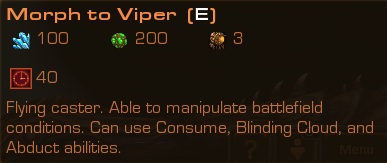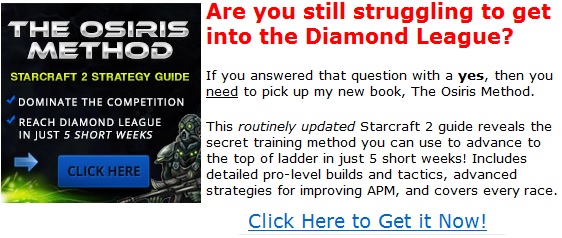Starcraft 2 New Heart of the Swarm UnitsStarcraft 2 Strategy Guide --> Heart of the Swarm Guide --> New Units in HotS (you are here)
In this guide, you will find a list of new Heart of the Swarm units, their pictures and tooltips, as well as video guides demonstrating all of these units in action. You can click on the name of a specific unit in order to be taken to a full guide on that unit where abilities, stats, and strategies are discussed in detail. Note: Campaign-only units will be covered in our HotS Campaign Only Units guide, as these units are unavailable in competitive play. New Protoss Units in HotSProtoss players get access to three new units in Heart of the Swarm: the Mothership Core, the Oracle, and the Tempest. All three of these are flying units, giving Protoss the most versatile flying fleet in Starcraft 2.
The Mothership Core is designed to fix some primary Protoss weaknesses: namely its susceptibility early attacks, its lack of options for harassing in the early game, and its lack of mobility in the late game. The Mothership Core is a flying unit with a decent ground attack, so it can harass enemy workers in the early game. As a flying unit, it also provides vision of the high ground, making early Stalker offensives much more viable. Its Photon Overcharge ability is a very powerful defensive skill that is hard to overcome within the first 10 minutes of a game. Finally, its Mass Recall ability gives the Protoss army the ability it needs to defend multiple expansions.
The first two abilities help provide the Protoss player with more vision. Revelation allows Oracle to see what targeted enemy units see, whereas Envision allows the Oracle to become a detector. The function of these two abilities is to reduce reliance on the Observer. It is only with the Oracle that the Protoss player is able to skip a Robotics Facility entirely in the early game. Note that players still get Observers though in the late game since Observers are cheaper, cloaked, and always active as detectors.
The Oracle also has a third skill, Pulsar Beam which grants it a temporary, powerful ground attack which drains energy while it is active. It does a lot of damage per second, especially to enemy workers, but cannot stay up for long. The Oracle's very low HP but high supply count and resource cost make it not practical to use for damage-dealing in your primary army. Instead, players like to rush to the Oracle and going in for sneak attacks on the enemy's mineral line. If the enemy does not react very quickly, this is a very effective tactic.
The Tempest is akin to a flying Siege Tank. It does not deal in splash damage or does not hit quite as hard as a Siege Tank, but makes up for that by being a flying unit which does not need to morph into and out of siege mode in order to move. The Tempest excels at destroying massive anti-air units. It deals nearly 3x bonus damage to massive air units. This includes Carriers, Battlecruisers, Colossi, Brood Lords, the Mothership, and other Tempests. It is a strong counter to all of these units. Since Protoss players have access to many massive air units (Colossi count as air), the Tempest has become an instant staple in late-game Protoss vs Protoss matches.
This unit is extremely strong for its supply cost. Despite this, the Tempest is not guaranteed to be included as part of the "Protoss Deathball". The reluctance of players to adopt this unit is not due to lack of strength, but rather its cost. Tempests require 125 resources invested for every supply point they fill (500 total minerals and gas for a 4 supply unit), whereas a Zealot only require 50 (100 resources for a 2 supply unit). Additionally, the Tempest requires a Fleet Beacon, which comes at a steep 300 minerals and 200 vespene gas! Due to their very high cost, Tempests usually do not appear on the field until the enemy produces massive air units or when the Protoss player takes their 4th+ base and can afford to invest in the extra infrastructure. New Terran Units in HotSTerran players get access to two new units in Heart of the Swarm. Both of these units are produced by the Factory and seem to be designed to give Terran players the option to play entirely mech based builds. In Wings of Liberty, Barracks units were produced heavily in practically every match-up.
The Hellbat has a similar fire-based, ground-only attack to the Hellion, but with a much shorter range (but wider) range. The Hellbat deals noticeably more damage per hit and has more health as well. However, it is much slower than the Hellion (too slow to chase down escaping workers for example) and has a shorter range, making it much more likely to take damage. One thing however that completely separates it from the Hellion is that the Hellbat is biological. This allows the Hellbat to be healed by Medivacs, making it particularly potent when used as for a drop attack.
Hellbats are fragile however due to their lack of armor. This is made up for the fact that they are very cheap to produce and have a very fast build time. They also cost no vespene gas, which provides a nice mineral dump for Terran mech players. Hellbats were deemed too powerful in the beta during drop attacks, so now a single Hellbat fills up 4 of 8 slots in a Medivac. Hellions by contrast only fill up 2 slots.
The Widow Mine is reminscent of the Spider Mine from Starcraft 1 and the Wings of Liberty campaign. Unlike the Spider Mine however, the Widow Mine costs a lot more and does a lot more. The Widow Mine is its own unit and is produced at the factory. It also has a 2 supply cost and requires a modest resource investment. It can move on its own, can burrow and unburrow, can attack air units, and has a bigger range.
The Widow Mine also is not destroyed when it is triggered. Instead, there is a 40-second cooldown between attacks. Given that the Widow Mine's primary attack is strong enough to kill off light units in 1-hit and its splash damage is noticeable, the Widow Mine typically only needs to go off once in order to pay for itself. The Sentinel Missile deals 125 damage to its primary target, along with +35 damage to shields. The + damage to shields is applied first. For example, a Stalker has 80 Shields and 80 HP. The Sentinel Missile deals the +35 to the shields first, taking the Stalker down to 45 shields and 80 HP. The 125 damage to the primary target then kills the Stalker, allowing a Sentinel Missile to 1-shot a Stalker. New Zerg Units in Heart of the SwarmThe Zerg gets access to two new units in Heart of the Swarm. These are both high tier utility units that give the Zerg the ability to be much more efficient and strategical in their gameplay.
While the Locusts only live for 15-25 seconds (depending on upgrades), they do live long enough to travel remarkable distances before dying. As a result of the distance these Locusts can travel before dying, the Swarm Host is effectively the longest-ranged unit in game. Prior to the Swarm Host, the Zerg was terribly inefficient at handling players who turtled inside of their natural base and built up a huge army. This was very common in Zerg versus Protoss, where Protoss players would hide inside their natural base, using Force Field to prevent the Zerg from attacking. The Protoss player would then max out before attacking, and there was not much the Zerg could do about it except try to expand all over the map.
With the Swarm Host, the Zerg player now has an option for turtling playstyles: Locusts cannot be kept out permanently with Force Field as eventually Sentries will run out of energy. If they do not use the energy, eventually the Locusts will wear down the turtled player.
The Viper affords players to play an entirely ground-based approach, even in the late game (the Viper does not require a Spire). In Wings of Liberty, Zerg players had to get air units in order to handle large numbers of Colossi or Siege Tanks. Now, the Viper can neutralize the Colossus by using Abduct and the Siege Tank by using Blinding Cloud. Additionally, the Viper allows Zerg players to fight on equal resource footing with other races should their micro be up to the challenge. Most Zerg players in Wings of Liberty relied on using the power of Zerg macro to overwhelm their opponent in the mid-game through inefficient but overpowering exchanges of units. In the resource lost tab, Zerg players were considered to be doing good if they were not too far behind.
The Viper when combined with the Infestor has changed this - the Zerg can decisively come out ahead in the resources lost tab even when armies of equal strength are pitted together. The Viper can completely neutralize entire armies via Blinding Cloud. Normally, enemy units would simply run out of Blinding Cloud when it was cast on the ground, but if you can root them in a cloud with Fungal Growth, the enemy not only is sitting there taking damage but cannot attack your ranged units. I have seen 4 Vipers and 6 Infestors allow a Zerg army to take out a massive Marine, Maruader, and Medic ball in this manner without losing a single unit. Once units are trapped by Fungal Growth, Blinding Cloud is thrown down and ranged units like Roaches and Hydralisks can move in to clean up the ball. The ranged units trapped under Blinding Cloud cannot actually shoot back at the Roaches and Hydralisks. Fungal Growth is refreshed to keep the units locked down and everything is cleared by the time this second Fungal Growth wears off. New Units in Heart of the Swarm - ConclusionAfter playing with all of these units, I have to say I am very impressed with how well thought out these changes were made. Each race now no longer "has" to pick certain units in the late game thanks to the introduction of these units. Protoss players used to have to get a Robotics Bay in order to get an Observer in order to handle cloaked units. They now can go entirely air for Tier 2 and 3 thanks to the introduction of the Oracle. Terran players used to have to go Bio in practically every game, as pure Mech ended up with too many unspent minerals in the late game. The Hellbat gives Terran players a Marine-like mineral dump that compliments other mech units very well. Zerg players used to have to get a Spire when playing Protoss players to handle Colossus, but now Roach, Hydralisk, and Viper is an effective combination against a ground-based Protoss army. Zerg players can also now effectively use a micro-oriented caster-based composition and win games without an economic advantage. |
Don't be shy - share this page on G+ and Twitter!
Sign up for my Free Starcraft 2 Mini-Course where I reveal my best strategies not seen anywhere on this site!
Starcraft 2 Strategy Guide Privacy Policy Contact Us Disclaimer
©2013 www.osirissc2guide.com

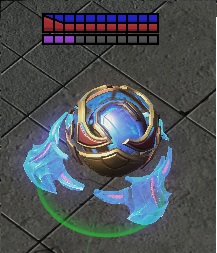 The Mothership Core is a new Protoss air unit that can be produced at the
Nexus as soon as you get a Cybernetics Core. Protoss players can only get 1 Mothership Core, as this is a very
powerful caster that significantly increases the strength of the Protoss army.
The Mothership Core is a new Protoss air unit that can be produced at the
Nexus as soon as you get a Cybernetics Core. Protoss players can only get 1 Mothership Core, as this is a very
powerful caster that significantly increases the strength of the Protoss army.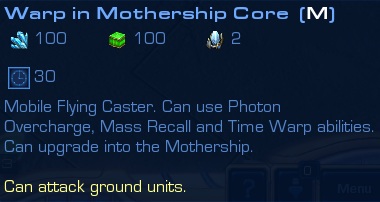
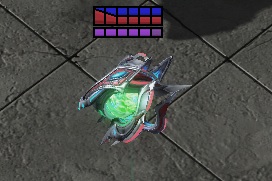 The Oracle is a new Protoss air unit that is produced at the Stargate. It does not
require a Fleet Beacon. The Oracle has no attacks of its own but instead has energy and three special
abilities.
The Oracle is a new Protoss air unit that is produced at the Stargate. It does not
require a Fleet Beacon. The Oracle has no attacks of its own but instead has energy and three special
abilities.
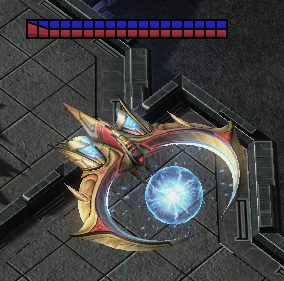 The Tempest is a Protoss flying unit introduced in Heart of the Swarm. This massive
air unit has a very slow attack with the incredible range of 15. By comparison, the Colossus with Extended
Thermal Lance only has a range of 9.
The Tempest is a Protoss flying unit introduced in Heart of the Swarm. This massive
air unit has a very slow attack with the incredible range of 15. By comparison, the Colossus with Extended
Thermal Lance only has a range of 9.
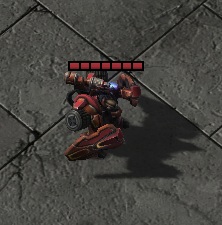 Even though the Hellbat is a new "mode" for the Hellion, it truly is an entirely
different unit for the Terran race. Once players build an Armory and subsequently research "Transformation
Servos" (found at the Tech lab on the Factory), players can morph their Hellions into Hellbats and their
Hellbats into Hellions for no additional cost.
Even though the Hellbat is a new "mode" for the Hellion, it truly is an entirely
different unit for the Terran race. Once players build an Armory and subsequently research "Transformation
Servos" (found at the Tech lab on the Factory), players can morph their Hellions into Hellbats and their
Hellbats into Hellions for no additional cost.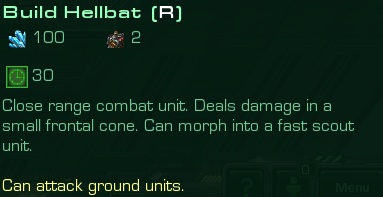
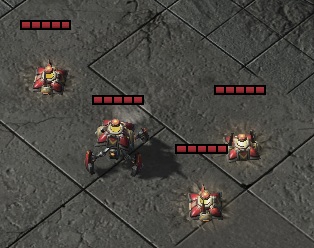 The Widow Mine is a new unusual Terran unit with no traditional attack of its
own. Instead, it burrow in the ground and attacks enemy units that get to close with a powerful, explosive
attack.
The Widow Mine is a new unusual Terran unit with no traditional attack of its
own. Instead, it burrow in the ground and attacks enemy units that get to close with a powerful, explosive
attack.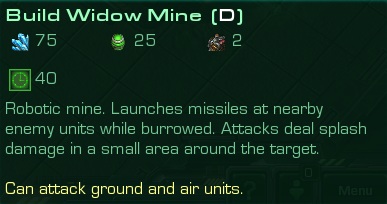
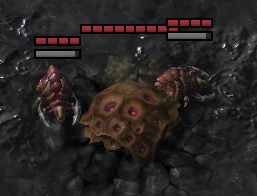 The Swarm Host is a burrowing unit that regularly produces minions when
burrowed. These minions, called Locusts, are short-lived ground units with 65 HP and a very powerful ground
attack.
The Swarm Host is a burrowing unit that regularly produces minions when
burrowed. These minions, called Locusts, are short-lived ground units with 65 HP and a very powerful ground
attack.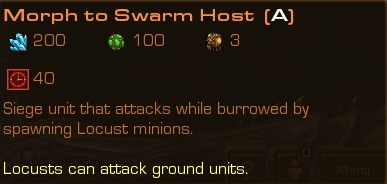
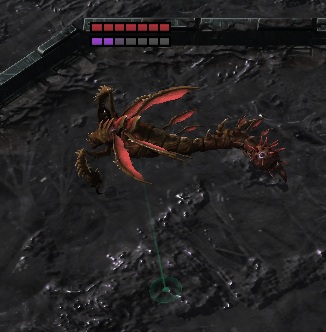 The Viper is a new tier 3 flying casting unit with no offensive abilities. Instead,
it can grab enemy units and pull them to its current location (Abduct) as well as place clouds on the ground
which prevent all units in the area of effect from performing ranged attacks (Blinding Cloud).
The Viper is a new tier 3 flying casting unit with no offensive abilities. Instead,
it can grab enemy units and pull them to its current location (Abduct) as well as place clouds on the ground
which prevent all units in the area of effect from performing ranged attacks (Blinding Cloud).